A rich stock enhances and deepens the essence of any recipe by aligning its fundamental flavors. Seafood stock is perfect to use in gumbos, etouffee, creoles and most other seafood dishes because it provides another layer of seafood flavor. The slow cooking method extracts an intense quality from shrimp and crab shells, oysters, fresh vegetables and basic herbs and spices. The best part is that this seafood stock can be made in large batches, then kept frozen in smaller quantities to have when you need it.
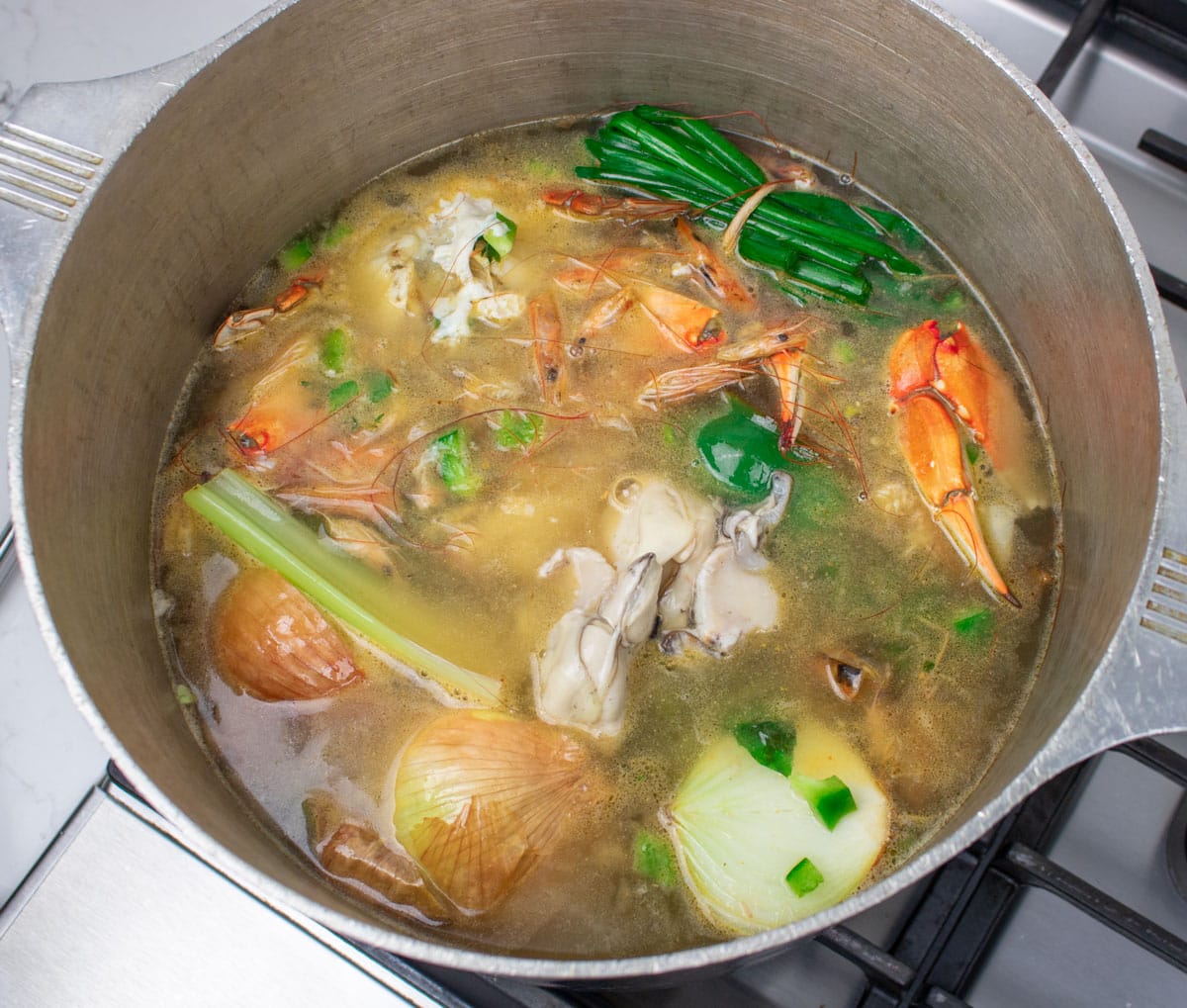
This post is not sponsored, but you will find affiliate links on this page. As an Amazon Associate, I earn from qualifying purchases. The price you pay as a consumer does not change, but I may make a small commission based on your purchase.
If you want to just skip to the recipe, click the "Jump To Recipe" button above or the Recipe link below and you’ll go right there without having to scroll through my article.
Jump to:
Why is stock important?
A stock is a flavored liquid-base used for soups and bisques, gravies, sauces, braises and many other things. It brings an exciting dimension to a recipe by intensifying its character with foundation vegetables and herbs. Stock is aromatic but not salty and enhances other recipes by adding a structure that is not provided by plain water. Stock generally remains unseasoned beside the foundation vegetables and herbs, waiting for the final recipe to add the appropriate spices and salt. A well-made stock can be the difference between a good dish and a great dish.
Here’s What You Need
What do you need? Simple, fresh ingredients. A stockpot is not a garbage pail, fresh vegetables and herbs are crucial. If you wouldn't eat it, don't use it. Same with the seafood. Save your shrimp shells and heads and "gumbo crabs" in airtight freezer containers until you have enough to make a stock. If you are including oysters, make sure they are fresh.
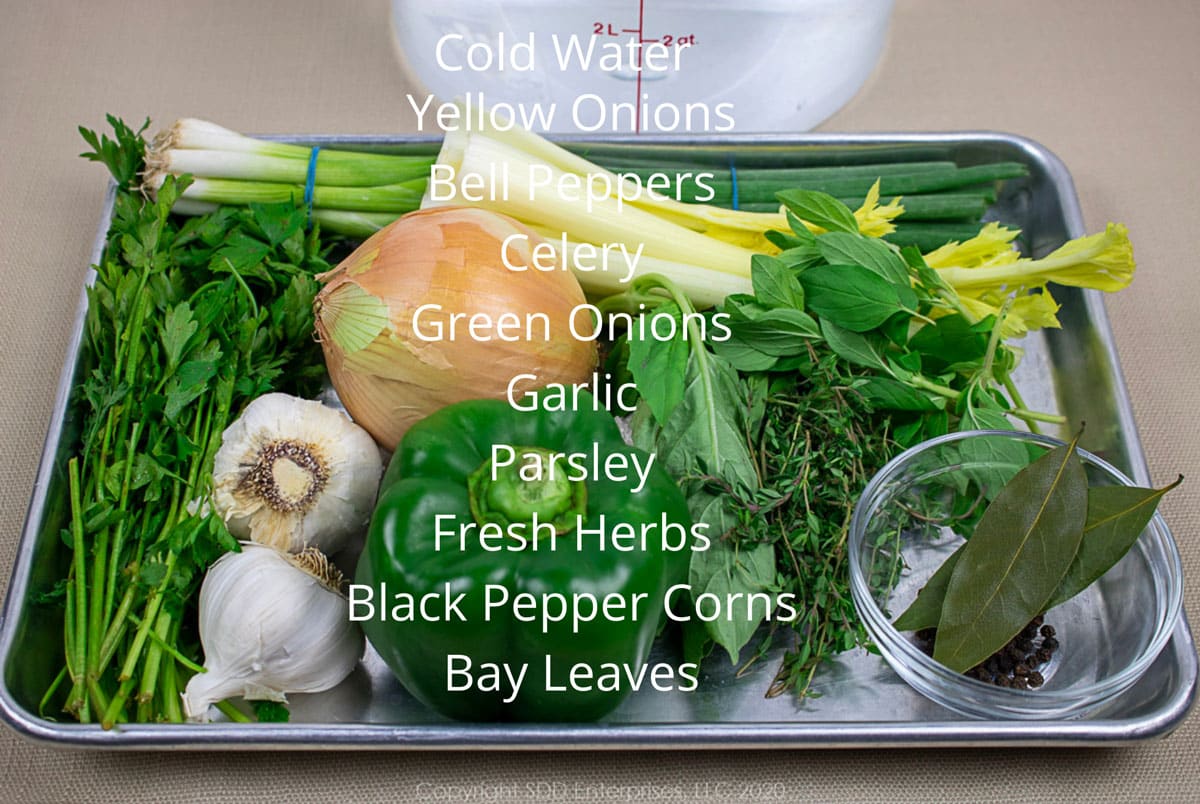
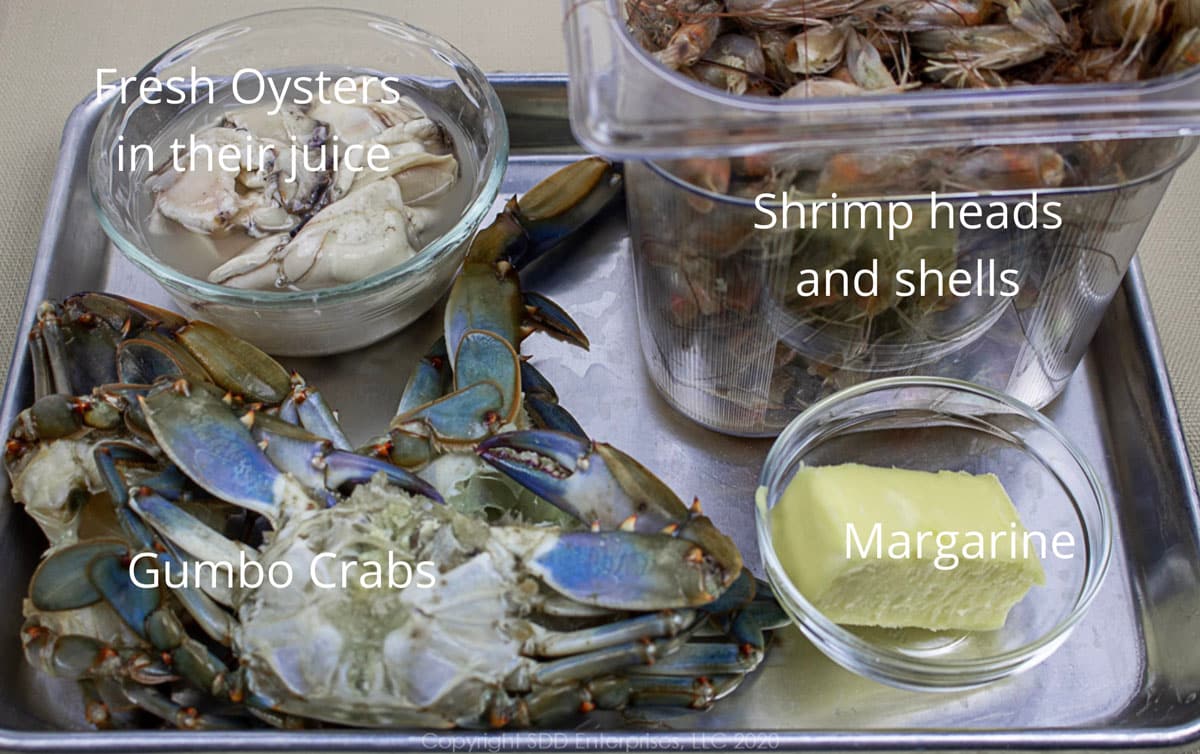
Equipment
Here is some of the equipment I used to prepare this recipe:
This post is not sponsored, but you will find affiliate links on this page. As an Amazon Associate, I earn from qualifying purchases. The price you pay as a consumer does not change, but I may make a small commission based on your purchase.
Large stockpot, cutting boards, cambro prep bowls, glass prep bowls, baking sheet, spice bags, cheesecloth, kitchen strainer, Chef’s knife, freezer containers
Here’s What You Do
First...you have a beer. Don’t look at your stockpot as a garbage pail. Prepare for this as you would any recipe. Pop the cap off a beer and read the recipe all the way through. Use fresh ingredients and be deliberate with the process and you will have a delicious rich stock to show for it.
Prep the seafood
Place the shrimp shells and gumbo crabs on a baking sheet. Melt ¼ cup of margarine and drizzle it over the shrimp shells and crabs. Mix this together with your hands to distribute the margarine.
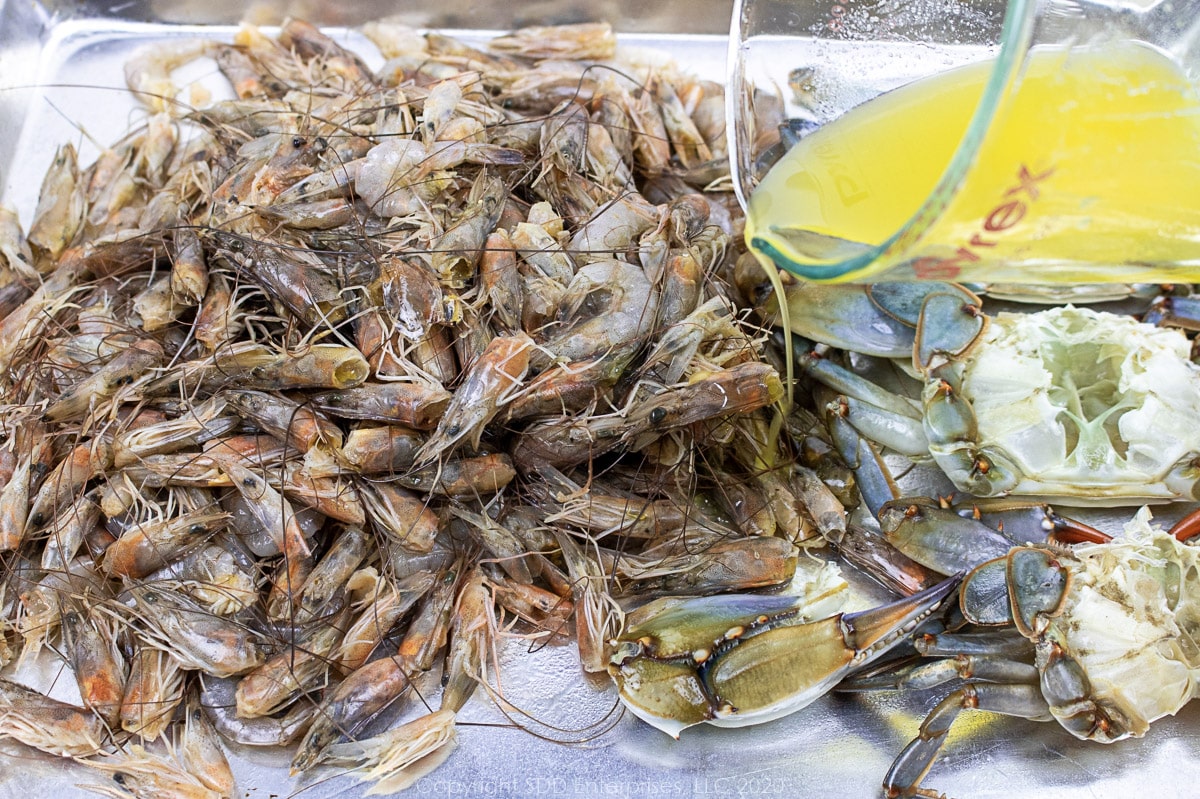
Place the baking sheet in a 400-degree oven for 20 minutes. When it’s done, set it aside and do not pour out the liquid that has accumulated.
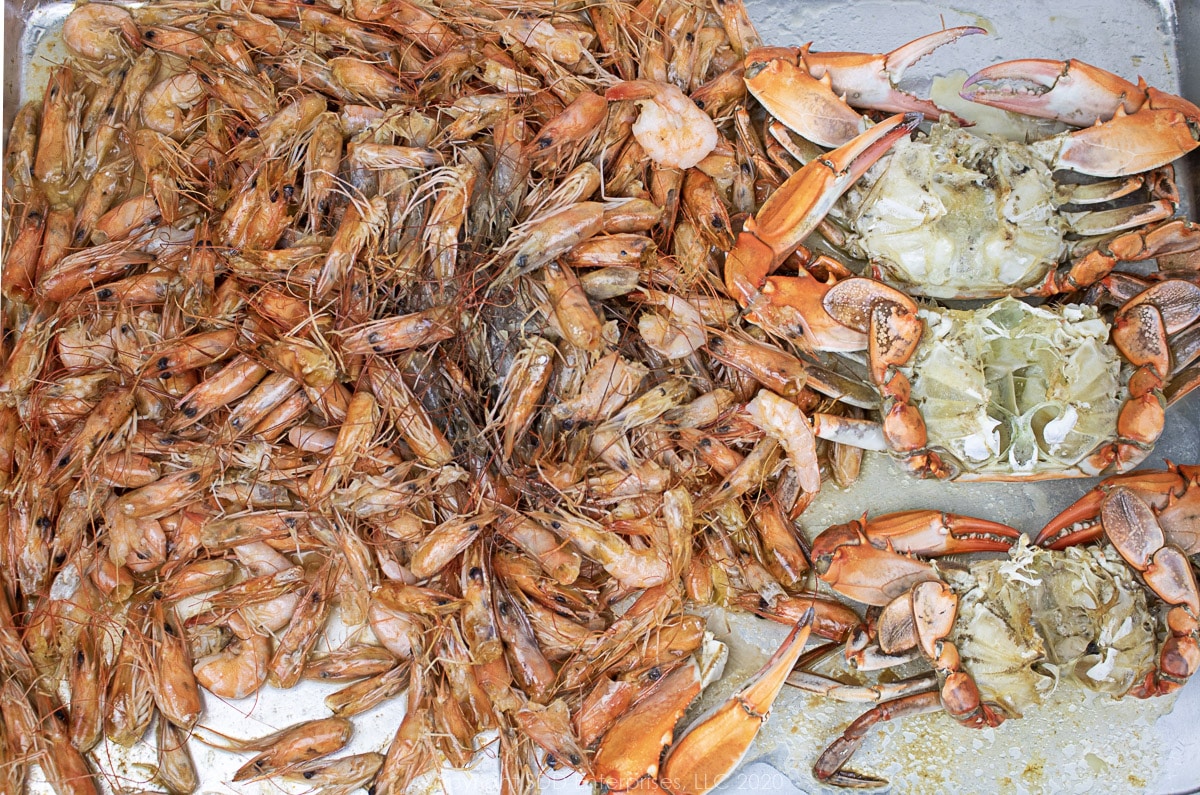
Prepare the vegetables and herbs
Remove any loose skin from the onion, but you do not have to peel it. Slice the yellow onion and bell pepper in half through the stem and garlic head through its equator. Chop the celery into approximately 4-inch pieces. Fold the green onions by three and tie together with butcher twine. Tie the parsley and herbs with butcher twine to make a bouquet garni. Place the peppercorns and broken bay leaves into a spice bag or tie them in cheesecloth.
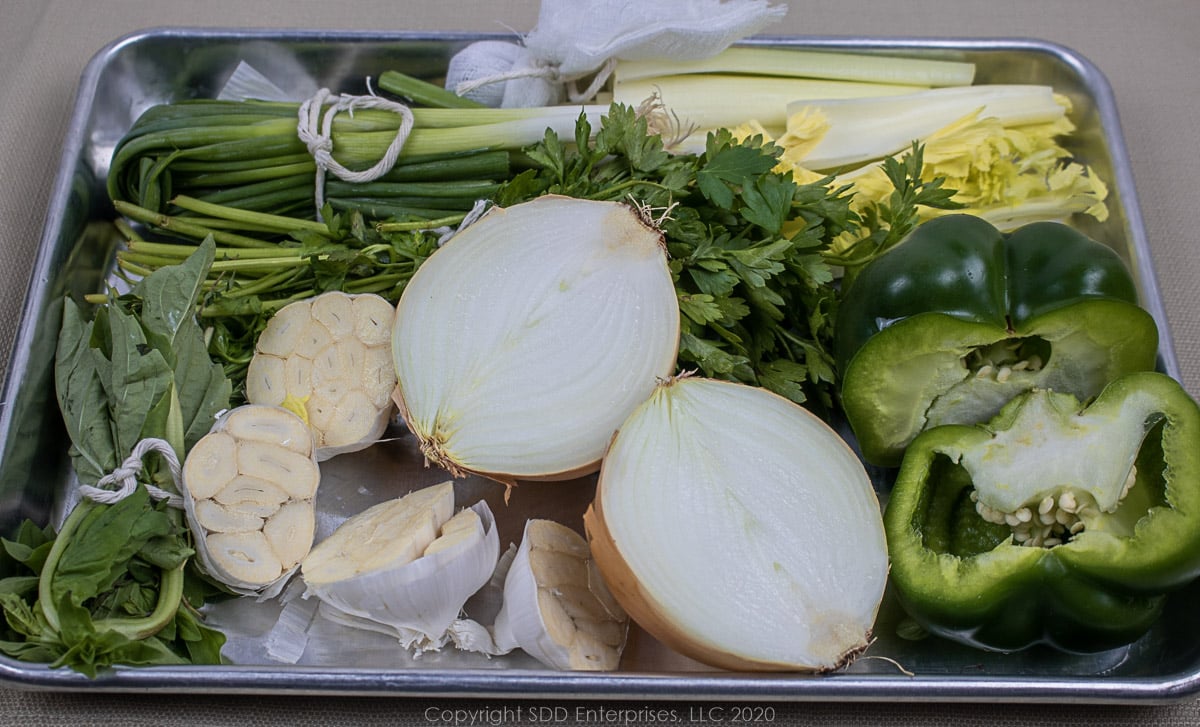
Fill the stockpot
In a large stockpot, heat the vegetable oil over high heat. When the oil is hot, place the yellow onions, bell pepper and garlic cut side down in the stockpot. Add the celery and sear for about 5 minutes.
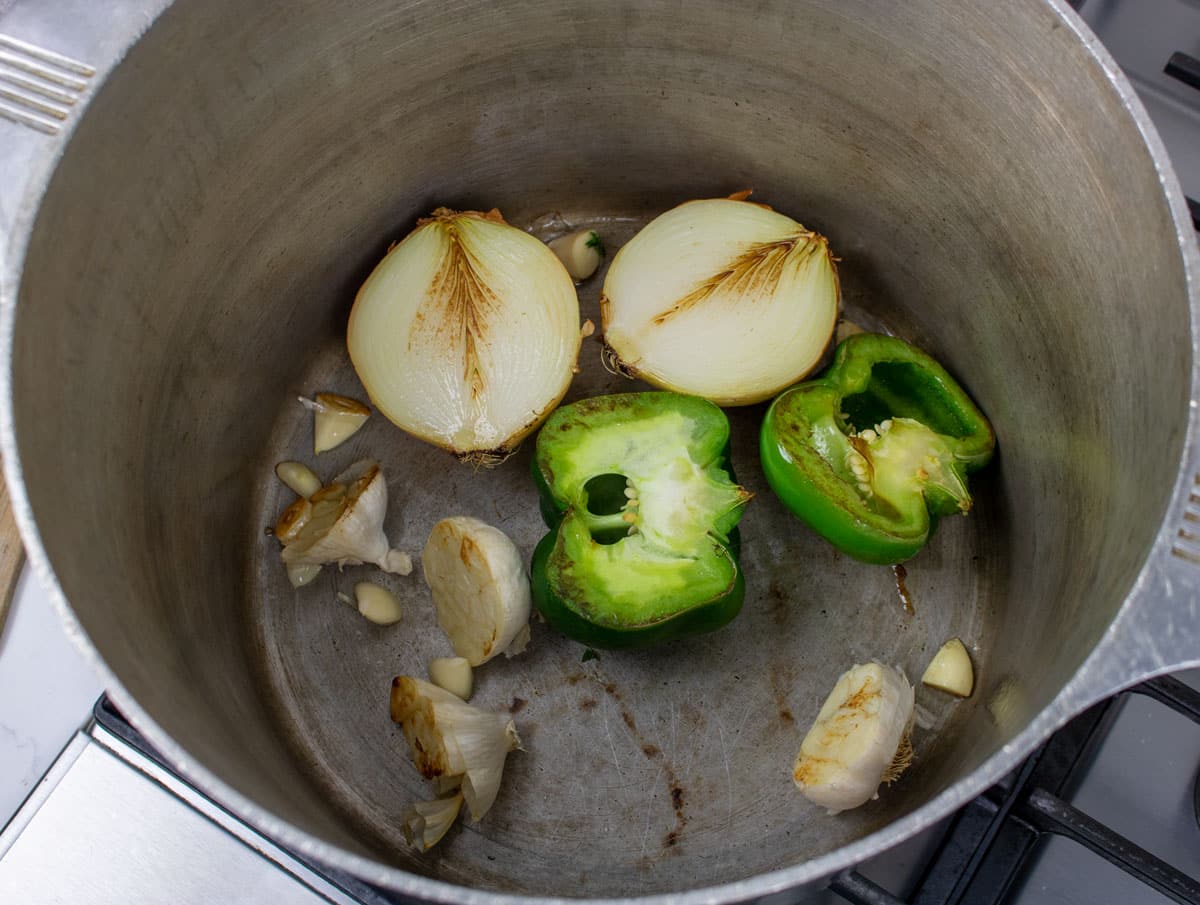
Add the green onions, parsley, herbs and spice bag and stir well.

Add the roasted shrimp shells and Gumbo crabs plus all the juice that accumulated while roasting. Add the oysters with their juice.
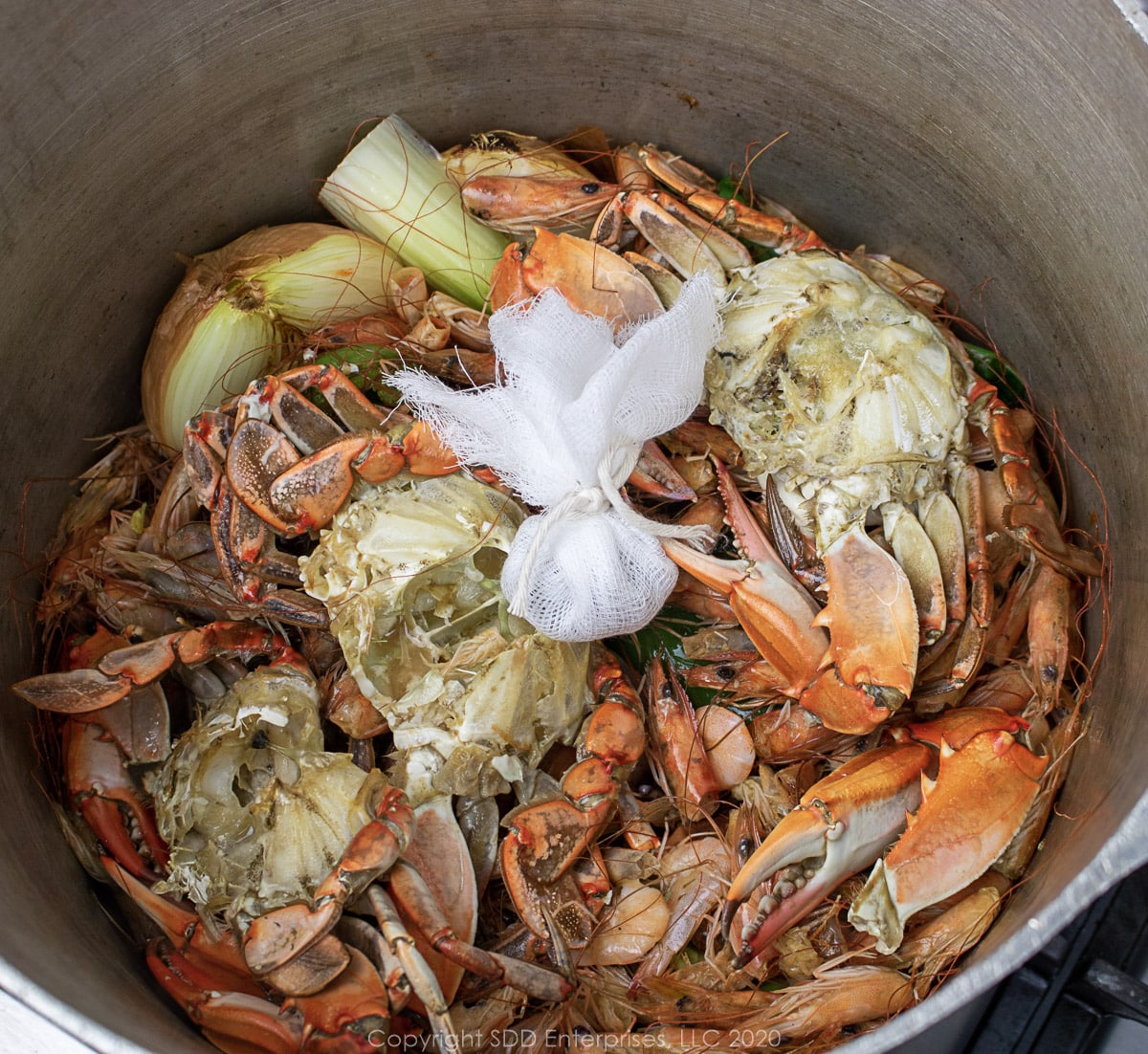
Pour in 16 cups (4 quarts) of cold water and stir everything together well.
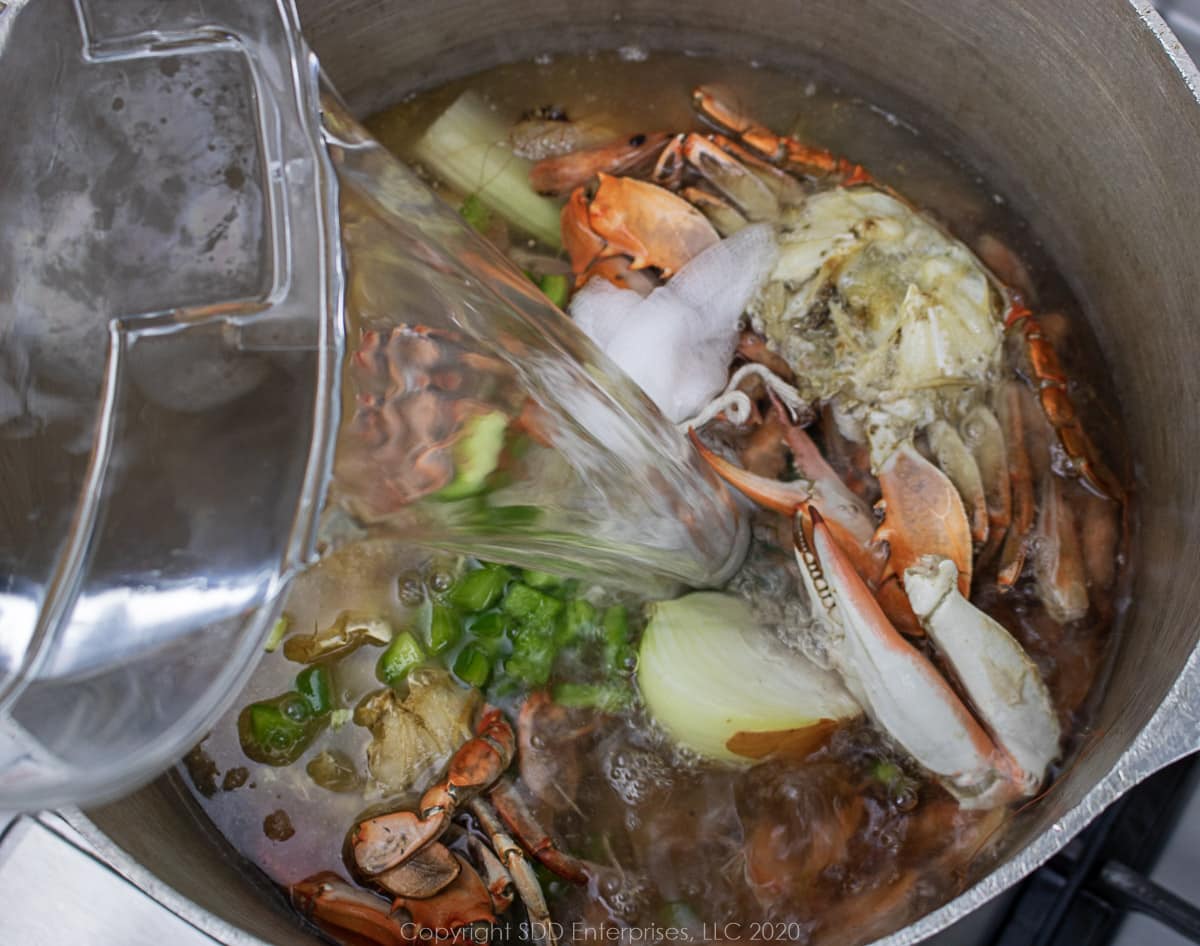
Simmer and reduce
Bring the stockpot to a high boil for 5 to 10 minutes, uncovered. (Tip-cover the stockpot while bringing it to a boil, then uncover.)
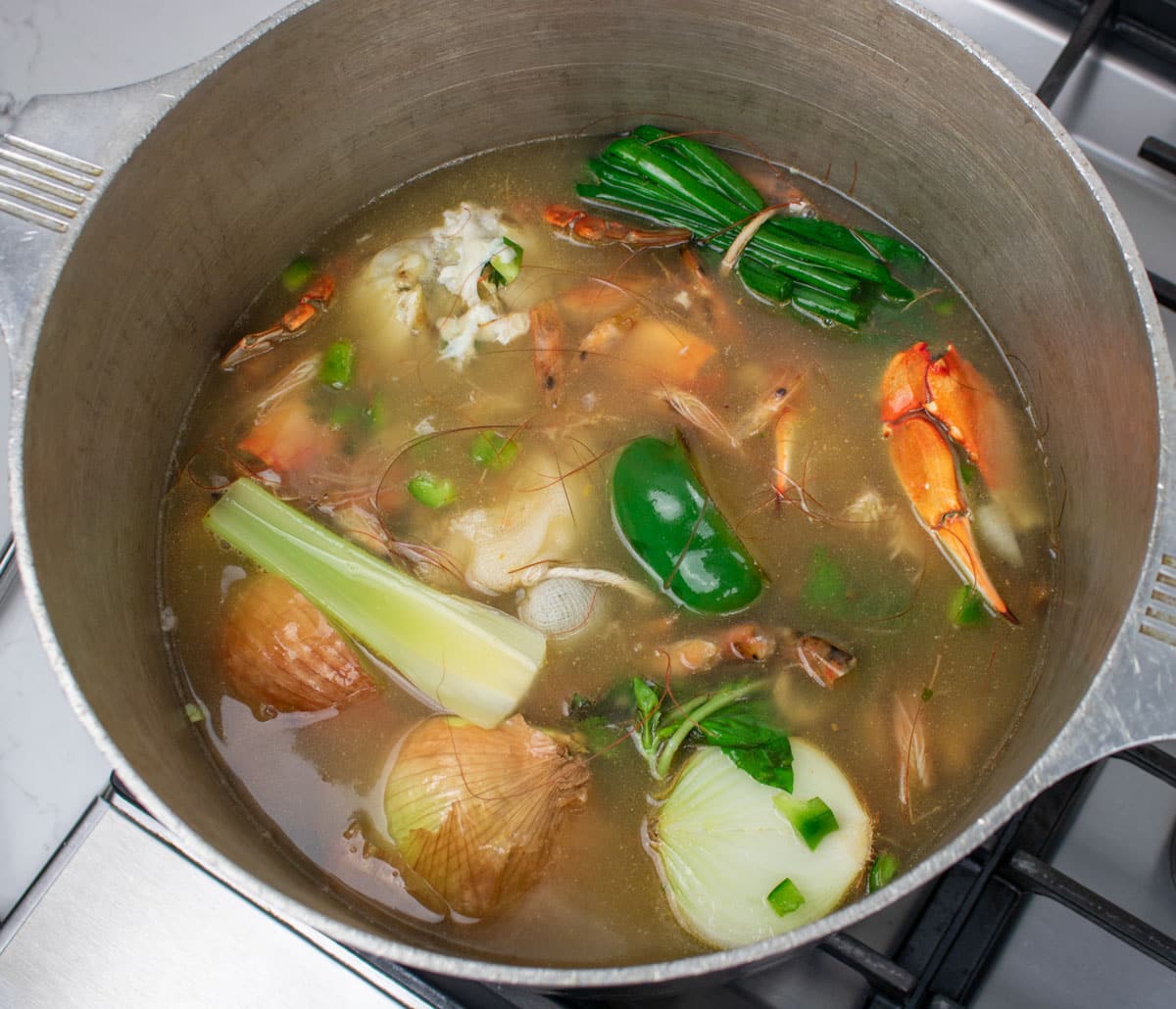
Reduce the heat, cover and slowly simmer for about 2 hours, stirring occasionally. After 2 hours, remove the lid and continue at a low simmer for another hour. If it looks like the liquid has reduced by about 50%, remove the stockpot from the heat.

Allow it to cool and strain the stock
After it cools for about 30 minutes, remove the solids with a slotted spoon into a strainer over a bowl large enough to hold 8 cups. Let the solids drain for about 15 minutes. Discard the solids, then pour the remaining liquids through the strainer (optionally use some cheesecloth or a filter in the strainer). This should yield about 8 cups.

Hints and Tips
If you are not going to use the stock immediately, place it in an airtight container and refrigerate. The stock will be good for 3 to 4 days. If you are not going to use the stock within a couple of days, place it in freezer containers with enough headroom to allow expansion. Make sure the containers are airtight and it will last 4 to 6 months. I recommend freezing in 2 or 4 cup portions, making sure to place a label on the containers with the name and date made. When you are ready to use it, it can be defrosted in cold water (change the water every thirty minutes), in the refrigerator overnight, or in a large saucepan over very low heat.
This is a very versatile stock and can be used in just about any type of seafood recipe. Since that is basically a regional exercise, use seafood that is common in your region. My recipe uses the basic seafood we find in South Louisiana recipes. We could add fish carcasses (remove the gills) or crawfish shells and heads. You can also use lobsters, scallops or other seafood that is available and may lend a nice quality that works for your particular recipe.
You should never throw your seafood shells away. Store them in the freezer (airtight) until you have accumulated enough shells to make a stock. For shrimp shells, this includes fresh shells as well as cooked shells. Save them all and they can be mixed together.
The finished stock will be an integral part of the recipe in which you use it. I try to keep the flavors of the stock basic to the main ingredient. You will salt the final dish as appropriate for the entire recipe so by not adding salt to the stock you can finish the final dish as needed.
While I think that keeping it as simple as possible produces the best results, you could add carrots, some dry white wine and other fresh herbs that you like. Remember, the stockpot is not a garbage pail, so whatever you use make sure it’s fresh and something you would eat. If using carrots, slice them in half lengthwise and sear them with the onions.
“Gumbo crabs” are primarily used for seasoning in stock and gumbo. To me, they are an essential ingredient in Seafood Gumbo. They are hard-shell crabs with the top shell removed and the cavity with the gills cleaned out. The legs and claws are still attached. These are generally smaller crabs that would not yield good lump meat but they pack all the flavor of larger crabs. They are sold frozen in seafood markets. Check out Cajungrocer.com for some (I am not an affiliate of Cajungrocer.com but I know they provide quality products and services).

In the mood for more Creole and Cajun dishes?? Check these out:
If you make this recipe:
- Tell us about it in the Comments section below
- LEAVE A RATING ON THE RECIPE-worthy of 5-Stars?
- Questions or Comments? that’s the place!
- SIGN UP FOR OUR EMAIL UPDATES so you don't miss anything!
- Post a picture and share it with your friends on our Social Media:
Yeah You Right!
Recipe

Homemade Seafood Stock
Here's What You Need
- 8 cups shrimp shells and heads
- 3 large Gumbo crab
- ½ pint Oysters with liquid
- ¼ cup Margarine
- 2 tablespoons vegetable oil
- 1 large Yellow onions
- 1 large Bell peppers
- 2 stalks Celery
- 1 bunch Green onions
- 6 sprigs Parsley
- 1 head Garlic
- 2 Bay leaves
- 10 Black peppercorns
- 4 quarts cold water
Fresh Herbs
- 2 sprigs Oregano
- 2 sprigs Basil
- 2 sprigs Thyme
Here's What You Do
- Place the shrimp shells and gumbo crabs on a baking sheet. Melt ¼ cup of margarine and pour it over the shrimp shells and crabs. Mix together with your hands to distribute the margarine.
- Place the baking sheet in a 400-degree oven for 20 minutes.
- Slice the yellow onion, bell pepper and garlic head in half. Chop the celery into approximately 4-inch pieces. Tie the parsley and herbs with butcher twine to make a bouquet garni. Place the peppercorns and broken bay leaves into a spice bag.
- In a large stockpot, heat the vegetable oil over high heat.
- Place the yellow onions, bell pepper and garlic cut side down in the stockpot. Add the celery and sear for about 5 minutes.
- Add the green onions, parsley, herbs and spice bag and stir well.
- Add the roasted shrimp shells and Gumbo crabs plus all the juice that accumulated while roasting. Add the oysters with their juice.
- Pour 16 cups (4 quarts) of cold water into the stockpot and stir everything together well.
- Bring the stockpot to a high boil for 5 to 10 minutes, uncovered.
- Reduce the heat to a slow simmer and cover, stirring occasionally.
- After 2 hours, remove the lid and continue at a low simmer for another hour.
- If it looks like the liquid has reduced by about 50%, remove the stockpot from the heat.
- After it cools for about 30 minutes, remove the solids with a slotted spoon into a strainer over a bowl large enough to hold 8 cups. Let the solids drain for about 15 minutes.
- Discard the solids, then pour the remaining liquids through the strainer (optionally use some cheesecloth or a filter in the strainer).
- This should yield about 8 cups.
- If you are not going to use the stock right away, place it in freezer containers with a little headroom for expansion and refrigerate.
- If you are not going to use the stock within 2 days, place the containers in the freezer. Make sure to label them with the name and date.

Comments
No Comments